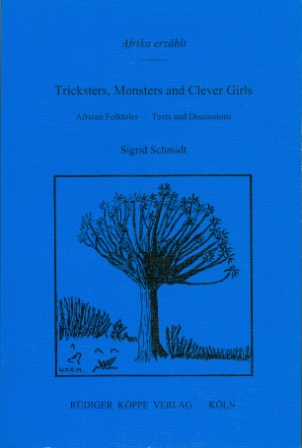
Tricksters, Monsters and Clever Girls
African Folktales – Texts and Discussions
Author: Sigrid Schmidt.
Series: Afrika erzählt Volume 8
2001383 pp.
1 original text in Nama/Damara with transcription and translation into English, 3 examples of songs in musical transcription, 2 tables
Text language(s): English
Format: 155 x 230 mm
560 g
Paperback
€ 49.80
Buy 'Tricksters, Monsters and Clever Girls' as a downloadable PDF document directly from our online shop »
Order 'Tricksters, Monsters and Clever Girls' as print edition »
This book has two aims: to entertain the reader by first-hand African folklore and to stimulate the researcher by its detailed study. The 64 tales have not been published before, the author recorded them in Namibia between 1960 and 1997. They range from myths to animal tales, from magic and ogre tales to legends and personal experience stories:
The Two Brothers and the Man with the Big Pot / The Sun is Killed Every Night / How Man Stole Fire from the Lion / Haiseb Frightened the Lions Away / Haiseb and the Woman who Ate People / Haiseb and the Woman Kaligogas / Haiseb and the Flying Lion / The Flying Lion and the Bullfrog / Haiseb and his Gemsbok Love / Haiseb Steals the Fire of the Ostrich / Haiseb and Eyes-on-his-Feet / Haiseb and the Miser / Haiseb, Mrs. Sleeping Rug and her Maid Close-by-breaking-wind / Haiseb Gets the Lion’s Prey by a Trick / The Chameleon and his Two Wives / Haiseb and his Two Wives / Haiseb and the Man who Cooked Himself / Haiseb Tries to Build a House by Magic / The Stupid Man / Young Lion and Young Gemsbok / The Baboons and False Prophet Agama / Little Lioness and her Friend / The Baboon and the Zebras / The Animal Assembly / The Sham-sick Lion / Jackal and Elephant in the Farmer’s Garden / The Drunken Tortoise at the Wedding Party / Jackal and Baboon at the Dance Party / Jackal, Hyena and the Tanner / The Jackal, the Leopards and the Baboon / The Jackal and the Dove / The Jackal and the Lion / The Son of Rain and Fire / The Girls in the Snake’s Village / The Singing Reed / The Girls who Went to Dig Wild Onions / The Frog Woman / The Daughters Born from Eggs / The Lion and the Young Wife / The Lion-Dog / The Warthog Husband / Eyes-on-his-Feet and the Man-eater / The Two Sisters and the Man-eater / The Husband who Killed his Wife / The Boy and the Man-eater / The Boy and the Bird / Turos, the All-Devouring Snake / The Poor Little Son and the Warriors / The Singing Bone / The Faithless Sister / The Boy and His Bull Calf / Jackal and Khaendaos / The Postman and Khaendaos / The Baby / The Tie / The Origin of a Song / A Python Swallowed a Child / The Water Snake / The Snake that Came out of the Grave / The Origin of the Name of the Village Usakos / The Lion Hunters / When I Tried to Stop the Thunderstorm / A Snake in our House / Haiseb ge xamanina ra âxare = Haiseb Curses the Wild Animals (Nama/English)
Part II gives background information on the narrators and the distribution of these stories in Southern Africa. Part III summarizes and updates the theoretical discussions which the author provided in the seven volumes published in German (1991–1999). They are the fruit of 40 years of attachment to Namibian folklore and the insights gained by listening to hundreds of different story-tellers.
The study focusses on the traditions of the Nama-speaking peoples but they are always seen in relation to further African lore. Special emphasis is laid on the stories about the mythical trickster because they are a unique treasure of the Khoisan peoples. But the essay also debates basic questions of the remaining genres: What are the characteristics of African magic tales in relation to Western magic tales? Why do African storytellers enjoy animal trickster tales inspite of the hero's questionable moral standards? Why do storytellers and audience laugh when gloomy ogre tales are told? Are there stylistic particularities and motif-like expressions in personal experience stories?
The author wants to help African readers to appreciate fully their local heritage but also to see it in relation to further African and international traditions, and to help Western readers to understand and appreciate African lore.
In her Catalogue of the Khoisan Folktales of Southern Africa, re-edited in 2013, Sigrid Schmidt lists all tales which were told by Khoisan people and said to have been learned orally. The catalogue consists of two volumes that can be ordered separately or together, see the following links:
Accompanying material:
- Catalogue of the Khoisan Folktales of Southern Africa
(ISBN 978-3-89645-870-4 ) - Catalogue of the Khoisan Folktales of Southern Africa
(ISBN 978-3-89645-871-1 ) - Catalogue of the Khoisan Folktales of Southern Africa
(ISBN 978-3-89645-872-8 )
| « back | Print version | [top] |
 Books
Books Audio
Audio Biographies
Biographies Series
Series Festschrifts
Festschrifts Journals
Journals